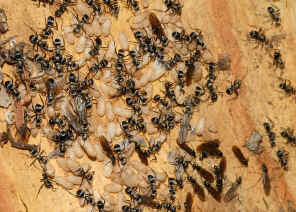Black Spiny Ant - Polyrhachis (Hagiomyrma) sp.
Subfamily Formicinae
This page contains pictures and information about Black Spiny Ants that we found in the Brisbane area, Queensland, Australia.

- Body length 10mm
- The worker ants have four spines on the mesosoma and the two on top of the petiole.



- We found this Black Spiny Ants nested under loose bark on a large gum tree trunk.



- Check carefully on the above photos you can find different stages of the ant development, include larvae, pupae, workers, winged male and winged female.

- Reference:
- 1. Polyrhachis (spiny ants) - myrmecos.net, 2005.
